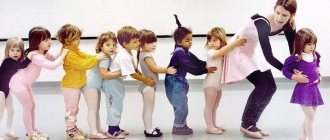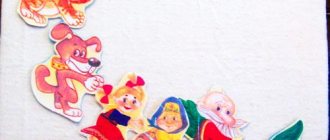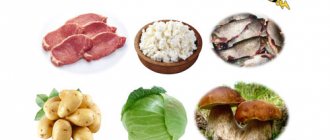Goal: to move from the initial distinction between big and small to the distinction between big by height, by age, by who knows how to do what. A comparison activity that requires reaching a new distinction. In Russian, the distinction big - small simultaneously fixes quality (large or small size) and denotes a quantitative measure for all other qualities (larger in height, width, age, etc.).
As a rule, children use the words big and small to name a set of characteristics. For this reason, with the help of the initial big-small distinction they have, they can build many situations that require building up the child’s system of distinctions.
Progress of the lesson
The teacher reads a letter to the children: “Dear children! Bunny is writing to you - Short Pants from a pine forest. Help me to understand! One day Bear, the owner of the forest, gathered us together and said: “A lot of unrest has begun to happen in our forest, different strangers are coming. It's time to put an end to this. This is what I decided: let all the big animals clear the forest paths and protect the small animals from foreign enemies. And let the small animals put the forest in order, collect garbage and various wood chips into piles. So we will have order in the forest.” That's what they decided on. All the animals went about their business, but about me, the Hare, a dispute arose: which one am I - big or small? The bear says: "Little." And the mouse says: “How small is the Hare? He's so big. Recently he jumped and almost crushed me, Little Mouse.” They argued and argued and never came to an agreement. Help me, guys, figure out: what am I - big or small? Logic of movement using the example of the “Bear” situation: 1. Defining the situation - in problem form, where initially a contradiction is laid down (the hare is considered both big and small at the same time) and unsolvability in action (for the hare). 2. Children try to resolve the situation by choosing one of the poles of the opposition pair: the hare is either big or small. 3. The problem is not resolved, the contradiction deepens due to the fact that positionality is maintained (the hare is both large for a mouse and small for a bear) and the question: what kind of hare really is?
The problem is not solved by a simple choice, but requires the restoration of the original activity situation for its solution.
4. Restoring the situation: what the bear wanted was to restore order in the forest, taking into account which animal can do what.
What was the bear doing? Through acting out, it turns out that he divided all the animals by height. Here we enter the mental plane: distinctions are not something that exists naturally, on things, but something that is determined by the context of the situation and the goals of the speaker and the acting subject.
5. In thinking - semantic deepening and differentiation of distinctions. For example: who is bigger - a baby elephant or an adult hare?
Children get confused and find it difficult to give a definite answer. —And how do we look at it, how do we compare? —By year, by height, size.
Different understandings of big and small are schematized. -Which is better to be - big or small? Children express different opinions: “A little one can do nothing.” “But the big ones can do a lot of things.” The third understanding is fixed: size, age, skills.
6 Return to the situation. Which of the three understandings can help the bear? We choose the third: divide all the animals according to who can do what. As a result, the hare turns out to be a postman - he runs fast.
Progress of the lesson
Cheerful music sounds.
Educator: I’m so glad to see everyone now, Let’s hug you all, Smile at each other and laugh together!
There is a knock on the door.
Educator: Who came to visit us, look who came!
He brings in a toy bear.
Educator: Who came to visit us?
Children, together with the teacher, look at the bear, say hello, discuss and attach parts of the bear’s body.
Educator: Mishka invites everyone to visit.
Where does Mishenka live? CHILDREN'S RESPONSES.
Educator: To come visit us, you need to walk along the path.
The song from the cartoon “Winnie the Pooh” sounds: “Who comes to visit in the morning...”
Walking on a ribbed board one after another
Children approach the pine cones scattered on the floor; there are two baskets nearby: a large one and a small one.
Educator: Mishka was walking through the forest, carrying pine cones in a basket. He stumbled and fell, immediately losing his cones. Who will help Mishka collect all the cones? We will collect the cones with you and sort them into baskets.
Children and the teacher examine the cones, note the difference in size, the teacher suggests putting the cones into baskets: large cones in a large basket, small cones in a small basket.
Game “put the pine cones into baskets”
Educator: How pleased the bear is, well, thank you, kids, My pine cones were laid out, the bear was very pleased. Now look at the baskets, first the big one, then the small one.
EYE GYMNASTICS ARE BEING CARRIED OUT.
Educator: The bear wants to play and stretch its paws. Let's play with the bear together, and repeat after the bear!
Physical training is being held
The bear is walking through the forest. walking in a flock A bear is walking through the forest. walking in a flock He puts the cones in his pocket. squats He puts the cones in his pocket. squats
He gained a lot of cones, he spread his arms to the sides. He didn’t lose a single one. turn their heads to the sides Oh yes bear, well done, clap their hands Our song is over! clap their hands
Educator: So you and I came to visit Mishka. Look, guys, Mishka wants to treat us to tea, he has placed colored saucers on the table. Let's help him. Place cups of the same color on saucers.
Didactic game “Find a cup the same color as the saucer”
(The teacher helps some children arrange mugs by color on saucers, clarifies and repeats with the children the color of the mug and the color of the saucer. Mishka thanks the children and offers them to drink tea.)
A didactic game “Washing your hands” is being held
We open the water tap - they finger it,
We are not afraid of water, - they stretch out their hands forward
We wash ourselves clean - imitate washing our hands and face
We smile at each other! - smile at each other
MAGAZINE Preschooler.RF
Summary of an integrated lesson in the middle group “How bears winter”Prepared and conducted by teacher Arabachyan R. A. Municipal preschool educational institution “Kindergarten No. 225”
Goal: Formation of children's ideas about the peculiarities of wintering bears.
Tasks:
Educational:
- Develop curiosity and educational interest through the discovery of new ideas about animal life.
- Develop creative imagination.
- Develop fine motor skills and accuracy in work.
Educational:
- Cultivate an interest in the life and habits of animals.
- Cultivate a kind attitude towards animals.
- Foster love and caring attitude towards baby animals.
Educational:
- To form an idea in children about the peculiarities of wintering animals.
- Improve skills in working with paints and brushes.
- Enrich children's vocabulary with new words.
- Strengthen the ability to draw round objects. Encourage accurate representation of the subject.
Children's ideas: In winter, the bear hibernates. A mother bear gives birth to cubs in her den. They are blind and naked, they need maternal care. The bear keeps them with her, among her warm wool. She feeds the cubs with her warm mother's milk.
Progress of the lesson
On the surprise table on the left: a model of a winter forest, a hare, a squirrel, a bear, a den.
V.: Guys, today we have a winter forest on our surprise table. What interesting things can we tell about the winter forest?
- Is it good for animals in the forest in winter?
- How do they prepare for winter?
- Where is the bear?
Children's reasoning.
Conclusion: Different animals prepare for winter in different ways: the hare and the fox “put on” a warm fur coat, the squirrel dries mushrooms and collects nuts for the winter, the bear sleeps in a den, which is why we did not meet him in the winter forest
The right side of the surprise table opens: a den in the winter forest.
V.: Guys, look, what is this?
- What is the den made of?
- Let's pop in and see who's there?
Children: There is a bear with cubs!
V.: What kind of cubs, because we know that the bear entered the den alone, and we know that bears sleep in winter. It’s cold, winter, snow everywhere, no food, how will the bear look after them?
Paired interaction of children, enumeration of different opinions.
V.: You guys all have very different and interesting opinions, how can we find out the exact answer to the question of how bear cubs live in a den in winter.
Educational story (from literature): In winter, the bear hibernates. A mother bear gives birth to cubs in her den. They are blind and naked, they need maternal care. The bear keeps them with her, among her warm fur. She feeds the cubs with her warm mother's milk.
You see how many interesting things you can learn from the book. What new did the book tell us about bear cubs?
Conclusion: The cubs feed on the mother bear's milk. They are not cold in winter because the bear keeps them close to her warm fur.
V.: Bear cubs love to play. Let us also turn into little bear cubs and play with them.
Physical education minute:
We are funny guys Our name is bear cubs We love to jump and play, We love to climb and throw.
V.: Guys, today is a joyful day for the mother bear and the cubs. The cubs have a birthday. How can we congratulate them?
Children's reasoning.
Conclusion: It is customary to give gifts on birthdays.
V.: Let us also make gifts for the cubs with our own hands.
Drawing. The theme is “Treats for the bear cubs” of the children’s choice.
V.: You all did very well.
Presentation of gifts.
Q: Guys, what are we in the mood for? Why joyful?
Children's reasoning.
Conclusion: We are in a good mood because we did a good deed. It’s good for us because it’s good for the mother bear and the cubs.
| Next > |
Introductory part
Lesson topic: We will go to visit the bear.
Purpose of the lesson: To involve children in joint activities to develop cognitive activity.
Tasks:
- Create an emotional mood, activate children's speech development and vocabulary.
- Strengthen the ability to distinguish between sizes: large, small.
- Practice the ability to correlate the 3 primary colors (yellow, green, red).
- Develop attention, memory, auditory perception.
- Develop cultural, hygienic and self-care skills.
- Cultivate a friendly attitude towards each other.
- Prevent fatigue; create conditions conducive to the development of physical activity.
Dictionary:
- small;
- big;
- cones;
- mugs;
- saucers;
- colors: yellow, red, green.
Material and equipment:
- Teddy Bear toy;
- 2 baskets with cones (large, small);
- colored mugs and saucers;
- laptop;
- audio recordings.



